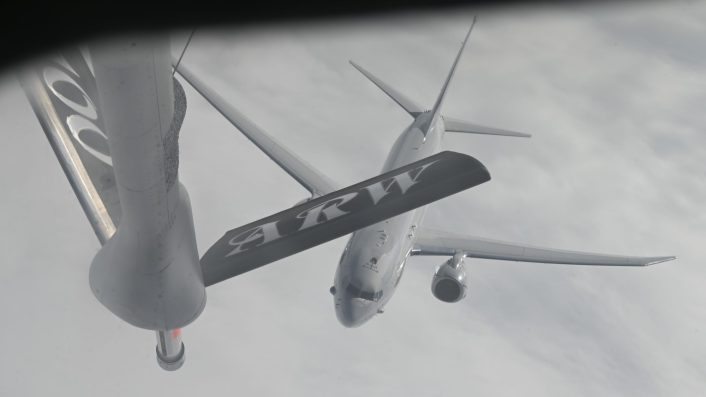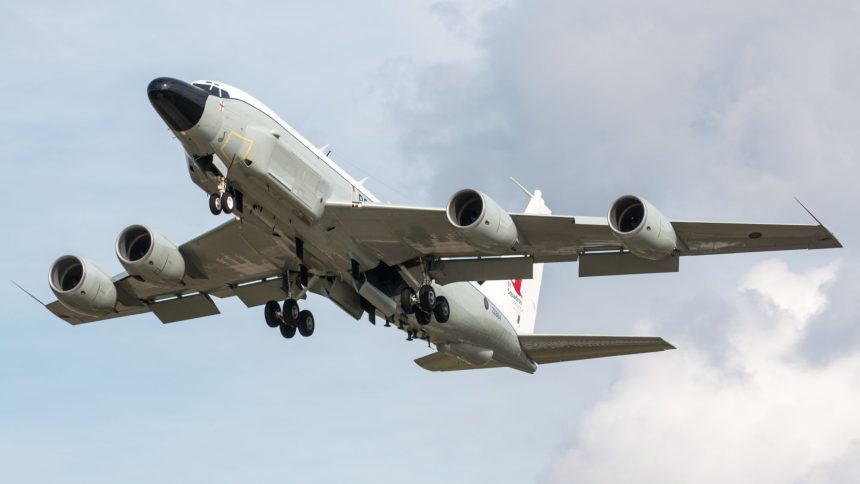The two British aircraft flew a 12-hour mission along the border with Russia, Belarus and Ukraine.
In a rare mission, a Royal Air Force (RAF) RC-135W Rivet Joint electronic surveillance aircraft flew a 12-hour-long mission on Oct. 9, 2025, patrolling the entire border along NATO’s eastern flank and the Black Sea. An RAF P-8A Poseidon (Poseidon MRA1 as per the British designation), also flew a part of the journey along the Russian and Belarusian border before conducting a patrol over the Baltic Sea.
The RAF’s statement said that the P-8A flew a “focused route” around the Baltic Sea, while the RC-13W proceeded southwards along the Finnish, Baltic nations’ border with Russia, skirting the Belarussian and Ukrainian borders, and finally entered the Black Sea before returning to the U.K.
The two aircraft were supported by a U.S. Air Force KC-135 Stratotanker assigned to the 100th Air Refueling Wing from RAF Mildenhall. The RC-135W and the P-8A took off from RAF Waddington and RAF Lossiemouth, respectively. RAF Waddington is home to the No. 51 Squadron, while RAF Lossiemouth hosts the No. 120 Sqn, No. 201 Sqn and the 42 (Torpedo Bomber) Squadron.
Always watching.
✈️ RAF Rivet Joint & Poseidon, with USAF KC-135 support, patrolled NATO’s Eastern Flank.
In response to Russia’s unlawful incursions, this mission shows NATO’s unity and readiness to defend its airspace. 💪#WeAreNATO #AlwaysReady #StrongerTogether pic.twitter.com/lxQnjfaCtm
— Royal Air Force (@RoyalAirForce) October 10, 2025
Flight observers tracked the RC-135W and the KC-135 refueler late in the morning of Oct. 9, taking off from RAF Waddington and RAF Mildenhall with the callsigns ASCOT7209 and LAGER51, respectively.
The RAF said the mission was in response to the repeated incursions of Russian drones and aircraft last month into the airspace of NATO countries including Poland, Estonia, and Romania. It called the support from the American KC-135 Stratotanker a display of “trans-Atlantic unity between NATO allies.”
Interestingly, Oct. 11, 2024, an RAF RC-135W Rivet Joint had become the first allied aircraft to complete a full transit along NATO’s eastern border, from the southernmost point of Greece to the northernmost point of Finland.
#RAF Royal Air Force
Boeing RC-135W Rivet Joint 1x#43C38C ZZ663 – ASCOT7209
The RAF RJ from Waddington early this morning is now over the Black Sea, after taking a look at the Russian border from the top of Finland all the way down to Romania.
This is the first RAF RJ… https://t.co/6eAaNJ1b9J pic.twitter.com/4hQj3Wkk8Q
— Armchair Admiral 🇬🇧 (@ArmchairAdml) October 9, 2025
The mission
Flight tracks showed the RC-135W, using the callsign ‘RRR7209,’ and the KC-135 briefly flew over the North Sea, where the former would have been refuelled mid-air. The two aircraft’s paths began converging around the northern part of the Black Sea, and had fully aligned outside Norway’s western seaboard, where the refueling may have taken place.
The KC-135 broke off and turned back southwards outside northwestern Norway, and the RC-135W continued further, turning east to trace the Russian border from over Finland.
The RAF, that put the total distance covered by the mission at 10,000 miles beginning from the High North, said the refueling from the KC-135 “extended the operational reach of the two RAF aircraft.” This means the P-8A might also have received fuel for the first time in an operational scenario after the trials late in September.
RAF RC-135W Rivet Joint #RRR7209 and Poseidon MRA1 operating along the entire length of the NATO’s eastern border today. pic.twitter.com/0gGuDgiGFV
— Olli Suorsa (@OlliSuorsa) October 9, 2025
In fact, the RAF’s P-8A recently tested mid-air refueling for the first time from the USAF’s KC-135 for the first time on Sep. 17, as a part of Exercise Cobra Warrior. This was to make up for the shortfall in the capability because of the absence of boom-equipped tankers in the RAF inventory.
At the time, the USAF called it a “simulated aerial refueling exercise,” while the RAF press release said two sorties took place. This would imply the first sortie may have only simulated the refueling, while actual connection and fuel transfer may have taken place in the second one.
As reported previously, the Voyager KC2s and KC3s (RAF designation for the Airbus A330 MRTT) are equipped with a hose-and-drogue refueling system and can only connect with the RAF’s Typhoons and F-35Bs, while they can’t refuel the RC-135Ws, P-8As, E-7A Wedgetail or C-17 Globemaster IIIs, which have receptacles only compatible with the boom.

As regards the latest mission, flight track observations about the RAF’s P-8A do not show it traveling over the Baltic Sea, and rather largely mirroring the route taken by the RC-135W, before turning westwards over Polish airspace, towards Germany. The aircraft then flew over the water during the return leg of its journey, close to the Russian exclave of Kaliliningrad over the Baltics.
The RC-135W, after taking off, headed northwards into the North Sea along the Norwegian coast, entered Finnish airspace, turned southwards and, while briefly over the Baltic Sea, flew over Estonia and Latvia, skirting the Russian border. It then continued southwards over Lithuania and Poland, just outside Belarusian and Ukrainian borders, and over Slovakia, finally turning east to fly over eastern Romania and enter the Black Sea.
The RC-135 flew a small circular route just outside the central Black Sea, before turning back, entering Romania. It then flew over Hungary, Slovakia, Czechia, Germany and the Netherlands before returning to the United Kingdom.
Oct. 9, 2025#RAF Waddington ==> #Finland -Russia border #RRR7209 #43C38C RAF RC-135W Rivet Joint
Refueling #RAF Mildenhall #Norwegian Sea#NoCALLSIGN #AE062B USAF KC-135R Stratotanker pic.twitter.com/vZbhgco8Vc
— Heo TaeJin (@AIYeyENGDdJkjTr) October 9, 2025
‘Collective resolve and coordination to defend NATO’
The RAF said the RC-135 and P-8 “collectively flew nearly 10,000 miles from the High North along the border with Russia, down past Belarus and Ukraine.” The service then added this mission allowed to demonstrate its “operational readiness and collective resolve of NATO.”
It then described both aircraft being “designed to gather intelligence using a range of methods to boost operational awareness and provide valuable data for analysis.”
“The RC-135 Rivet Joint, a key intelligence, surveillance, and reconnaissance (ISR) platform, is designed to listen to a vast range of different signals from across the electromagnetic spectrum, allowing it to eavesdrop on military communications,” said the RAF. “The P-8A Poseidon, which is specialised for anti-submarine warfare and can carry torpedoes and anti-ship missiles, flew a route focused around the Baltic Sea.”
Both aircraft “coordinated closely with NATO Allies across Europe,” providing “comprehensive situational awareness, monitoring activity across the Alliance’s eastern flank and deterring any potential threats to airspace.”
Oct. 10, 2025#RAF Waddington #NATO-Russia border #Black Sea#RRR7209 #43C38C RAF RC-135W Rivet Joint pic.twitter.com/c7KXlb6CmP
— Heo TaeJin (@AIYeyENGDdJkjTr) October 9, 2025
“This joint mission highlights NATO’s commitment to collective defence and its ability to operate cohesively in response to emerging threats. By integrating advanced surveillance and maritime patrol capabilities with air-to-air refuelling support, the RAF and its NATO allies continue to safeguard the Alliance’s airspace and uphold international law,” the statement added.
Early in September, drones from Russia violated Polish airspace, spurring NATO to launch Operation Eastern Sentry in Poland, with the RAF’s Typhoons from RAF Coningsby also deploying in the effort to bolster the alliance’s eastern flank.









